How to change your way of thinking?
It is obvious that in order to change our lives, we must start by changing our way of thinking. However, letting go of destructive beliefs and unfavorable mental habits is for many of us harder than it seems. From this article, you will learn how to make a major change of mind effortlessly and effectively.

Difficulties with changing their worldview usually result from a lack of understanding of the mechanisms affecting our perception and beliefs. That's why, I will start with answering three important questions:
- Do we see reality as it is?
- What do we need our beliefs for?
- Why is it so difficult for us to change our way of thinking?
Next, I will show you, step by step, two simple stages of learning how to change your mind:
Stage 1: Exploring your beliefs + "Discovering beliefs" exercise
Stage 2: The belief change cycle + "Mental experiments" exercise
Once you know the answers to these questions and do two simple exercises that I suggest, you will finally be able to unlock those areas of your mind that have always been closed and inaccessible.

Do we see reality as it is?
Hide the browser for a moment and look at your desktop. You can see many different icons in various colors. Folders, programs, games, movies, music, etc. Looking at an icon of a PC’s interface, you don’t actually see the process it stands for. After all, these icons are not scattered between the cables inside your computer case. They are just symbols that help you use the tool that is your computer. In other words, they are a visual representation of very complicated processes, both mechanical and digital.
So, what you see is a distorted picture of reality, the role of which is to make your life easier.
Our perception works in exactly the same way. We don’t see the world as it really is. All that we experience is a very simplified set of sensory impressions, by which we are able to function in our environment.
According to Donald Hoffman, a cognitive psychologist, our brain is not built to see reality as it is. He said that "evolution gave us an interface to hide the complexity of the world from us and guide adaptive behavior".
The perception of each species has been shaped so that it can adapt in the most effective way to the conditions of its life environment. For example, snakes can see infrared, whereas humans don’t have this ability. Each animal sees reality in its own way, none of which can be considered as correct or most objective.
Senses
Experiences
Beliefs
Values
Emotions
Plans
Expectations
...
Our way of thinking works in exactly the same way. Before you create an image of reality in your head, information you receive from the outside is run through your biological as well as psychological filters. The shape of your world map depends on what you experienced in the past, how you were brought up, which behaviors were condemned by your parents and which were rewarded. Each of us has a unique and subjective way of thinking and the first step you need to take to change it is to free yourself from this limiting belief that what you see, feel and think is the objective truth.
What do we need our beliefs for?
We don’t need our beliefs to accurately describe reality but to simplify our lives. Our way of thinking is like a navigation system, constituted of hundreds of opinions, thanks to which we know how to act and behave in the world. We need to have an opinion about ourselves to know how to treat ourselves. We need to have an opinion about other people to know how to approach and talk to them. We need to have an opinion about the essence and meaning of life in order to know how to handle the matters most important to us.
If we are convinced that people can’t be trusted, we will tend to be distrustful and careful around them. When we think that we are not worthy of love, we will reject the compliments and closeness offered by others. When we believe that in order to be happy, one has to suffer first, we will look for ways to inflict mental pain on ourselves.
Even the most destructive beliefs are meant to be somehow helpful to us:
- If a woman’s partner cheated on her three times in a row, she will start to believe that all men are pigs. The purpose of this belief is to protect herself from another disappointment.
- When everything goes wrong in someone’s life, they may think that this is simply bad luck. This belief helps them to shift responsibility onto some invisible power, thus protecting themselves from a feeling of guilt.
- After failing the same exam once again, a student may think that he/she is a good-for-nothing. This belief discourages the student from making further attempts, thus avoid any more devastating failures.
Of course, the fact that the purpose of this type of beliefs is to maintain our self-esteem or support our daily activities does not mean that they fulfill these roles well. In most cases, it is quite the opposite. They often hold us back and become a big obstacle to change or growth.
Nevertheless, you need to keep in mind one thing, namely that the purpose of beliefs is to simplify our lives (just as the icons on the desktop facilitate our use of computers), and not to reflect the truth about the outer reality.
How will you know when it's high time to change them?
Once you know that the role of beliefs is to make your life easier, the answer to the above question becomes obvious.
- Does your worldview make you feel happy, serene and emotionally free?
- Does it help you achieve your goals and build healthy relationships?
- Does it allow you to meet your needs freely?
If so, it means that your mental software is "healthy" and fulfills its role. If not, apparently there are some outdated malignant “programs” inside your head that need to be changed. Such mental clutter limits your ability to respond to life challenges adequately and effectively.

Why is it so difficult to change the way you think and how to do it in practice?
There are two main reasons why it is so difficult for us.
Firstly, nobody taught us about our perception of reality I described in my response to the first question. We have been raised to believe that what we think is true equals objective truth. That is why changing the way we think often seems an insane and absurd idea. We believe that reality is what it is and a change of mind would actually mean self-deception - a make-believe.
Secondly, it is often the case that when we start to accept the idea that there are chances our mindset is not so flawless, fear comes in. Somewhere deep inside we are afraid that everything we have believed in would turn out to be false and our whole world would collapse. We are afraid of having to admit that we were wrong, which in turn has a negative impact on our self-esteem. So we cling to our worldview, shutting out the thought that we might be way off beam. We stick to our guns and want to convince as many people around us as possible, because only then we feel safe.
A sense of security is one of the most important human needs. We must understand, however, that keeping the beliefs that make our lives harder doesn’t make us feel safe. Quite the contrary. A far safer approach involves experimenting with different perspectives and worldviews. They may prove much more useful to us for responding to life challenges.

Stage 1: Discovering your beliefs
If we want to learn how to change our way of thinking, we first need to know what it consists of. We are unable to work on something that we are not aware of. And often just realizing the beliefs that fill our head is enough to understand how useless they have been for us.
"Discovering beliefs" Exercise
Duration: approx. 10 minutes
Grab a pen and a piece of paper or just open a new document on your computer or smartphone. Ask yourself the following questions, one at a time, and take down all the ideas that come to your mind (regardless of whether the discovered belief is positive or negative). Only after you've exhausted the topic of the question, move to the next one.
- What do I think about myself?
- What do I think about life?
- What do I think about the world?
- What do I think about my abilities?
- What do I think about my past?
- What do I think about my future?
- What do I think about people?
- What do I think about work?
- What do I think about my job?
- What do I think about money?
- What do I think about love?
Of course, these are just examples of questions that you can ask yourself. I suggest you come up with your own. From the answers you will give, a partial image of your mindset will emerge. After completing the exercise, stop for a moment on each answer and ponder how this way of thinking affects your life. Ask yourself two questions:
- What do I feel when I think this way?
- How does this thinking shape my behavior?
Understanding how limiting beliefs influence your life is often a turning point in your work on changing them. It is an opportunity to realize how the world inside you generates your experience in the world outside you.
Place a tick next to those beliefs that have the most negative impact on you. You will tackle them first.
Stage 2: The belief change cycle
How to make a change of mind? It certainly cannot be forced. It is a process that takes shorter or longer but definitely takes time. Regardless of whether you practice personal development methods or not, your thinking evolves naturally and constantly. The exercises I suggested will certainly speed up this process, but remember that there are no shortcuts. No method will allow you to skip through the stages that are an inseparable part of the natural cycle of belief change.
It is impossible to make a leap from a belief of 100 % certainty to an entirely contradicting belief of 100 % certainty (unless the first belief was, deep down, no longer genuine and you’ve had doubts about it for a long time). Between the initial and final state of mind, there are two more steps that should be taken with a lot of patience and respect towards oneself:

Belief change cycle
- Belief A
I believe A is true.
- Doubt
I am not sure if A is true.
- Belief B
I believe B is true.
- Openness
Let's see how it works on the example of “People can’t be trusted” belief.
- At this stage, you are convinced that the proposition “People can’t be trusted” is true and you don’t question it at all.
- The second step (doubting) is a state in which you are no longer sure this belief is true. A disposition in your head opens up to the idea that this way of thinking doesn’t have to be right. It doesn’t mean, however, that you stop believing it. For now, you just allow for the possibility that it doesn’t have to be the way you see it. You break free from being blindly attached to the attitude "that's how it is, period".
- Step three (openness) is a state of opening up to a new thought. For example, if you have believed that all people can’t be trusted, at this stage you start to consider that the belief "Some people can be trusted" might actually be true (Note that I don’t suggest a belief that is entirely contradictory. Making yourself believe that “All people can be trusted" would be as much of self-deception as in the case of the belief "People can’t be trusted"). You start to verify the new belief in practice. You also wonder how it can affect your life. You observe your feelings and reactions related to the new way of thinking, although you are not sure yet if it is actually true.
- It is only when you feel that you want to include the new belief part in your worldview, you start to believe in it. At this stage, "Some people can be trusted" becomes self-evident truth to you.
Going through the belief change cycle consciously
You probably wonder how to actually go from stage 1 to stage 4 effectively and how to change your mind in real life?
Stage 1 -> Stage 2: Let's start with a shift from holding onto belief "A" to doubting whether it is in fact true. At this stage, I suggest you ask yourself two simple but extremely effective questions:
- Is this belief really true?
- In what situations is this belief not real?
The first question allows you to undermine your belief and gives you incentive to doubt and reflect on the rightness of the given proposition. The second question is about exploring situations in which this belief doesn’t work. Spend a day or two pondering over these questions. Remember that changing your mind is a process that shouldn’t be rushed in any way. Therefore, give yourself time before you fully enter the second stage of the cycle.
Stage 2 -> Stage 3: In order to move from doubting an old belief to becoming open to a new belief is to let yourself experience a new way of thinking. It is about trying out a new belief without any obligations, instead, with curiosity and openness. The second exercise will help you do this:
"Mental Experiments" Exercise
Duration: 1 or 2 days
This experiment starts with contemplation to ponder over the following questions:
- If the “B” belief was true, how would I feel?
- If the “B” belief was true, what would change in my life?
- If the “B” belief was true, how would my behavior change?
Next, your task is to presume, just for the next 24 or 48 hours, that the belief you’ve taken under consideration is true. You don’t have to believe in it, you only need to experience what it could be like if you believed it’s true. It's like trying on clothes in a store. Entering the fitting room doesn’t necessarily mean that you will buy that pair of pants that caught your eye. You want to try them on first, see how you feel in them.
You do the same with beliefs - for a day or two you keep looking at yourself and the world from a new perspective to see whether that way of thinking works for you.
Then, the shift from the stage of becoming open to the stage of adopting a new belief is going on in a natural way. If the new belief serves you well, it will most likely stay in your head. If not, you will dispense with it and return to the old way of thinking.
In order to support this process even more and strengthen your new belief, you can write it down on a piece of paper and carry it with you for a few days, giving it a read a few times a day. I am not speaking about affirmations here (you can find more on the subject of affirmations in the article The Affirmation Trap), but about free-flowing reflection on the “truth” of the new belief.
Mental/Thinking/Mind patterns
In this article, I did not touch the aspect of mental habits as a separate article is devoted to this topic. Thinking patterns are basically destructive thoughts that keep popping into your head and don’t want to leave you in peace. They are not a part of your worldview. They are just habits, a remnant of the past, unlike the opinions that you believe in and which are true for you. Usually they come to your head on their own accord, regardless of what you really think on certain subject. Most often they include thoughts like: "You are good for nothing", "You can’t do this", etc.
I hope that what you have learned in this article will help you you explore how to make a change of mind into healthier and more supportive one.
Remember to do it slowly, watch your own thoughts carefully and when the time is right ask yourself the above questions. Over time, your thinking will naturally evolve, making it easier for you to face the challenges of your everyday life.
So.. it's your turn now! Share in the comments section what beliefs you want to work on. Sometimes the very act of writing down a destructive thought can serve as a symbolic tossing it out of your head. And when we do it together, what will emerge here is a quite substantial set of beliefs that are worth tackling.
